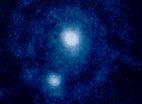

Of the nine planets in the Solar System, seven of them have moons. The largest moon in the Solar System is Ganymede, a moon of Jupiter. Ganymede is so large that it is bigger than both Pluto and Mercury.
The only moon with an atmosphere is the Solar System's second largest moon, the largest moon of Saturn. This moon is Titan and has an atmosphere twice as dense as the Earth's.
Some of the moons of Jupiter and Saturn are covered in ice and it is believed that below the ice of Europa is an ocean that could contain life!
Many of the moons of Uranus and Neptune are believed to be captured Kuiper Belt objects while Mars' two tiny moons are captured asteroids from the asteroid belt between Mars and Jupiter.
Earth's Moon is quite large. It has water under its surface and ice at the South Pole in craters the Sun never enters. Earth's moon is the only moon that bears any relation to the size of the planet except for Pluto's moon.
Pluto is believed to have once been a moon of Neptune since it is so small. With Neptune and Uranus having Kuiper Belt objects as their moons, and since Pluto is really just the largest Kuiper Belt object, this is possible.
Pluto's moon, Charon, is the largest moon in the Solar System in comparison to the size of the planet. Charon is over half the diameter of Pluto but less dense. Because of this Pluto is often thought of as a double planet and Charon is also known as Pluto's 'cosy companion'.
Neptune's moon Triton is probably the most interesting moon in the Solar System but Pluto's has an interesting point about it as well, which also has a similarity it shares with Earth's Moon.
Earth's Moon rotates once each orbit of the Earth, which means that the same face of the Moon is always facing the Earth. The far side of the Moon was not seen until October 1959 when the Russian space probe Luna 3 flew round the Moon and sent back pictures.
Pluto's moon Charon works in the same way. Charon always keeps the same face looking at Pluto but this is not the end of the matter. Pluto and Charon are even more synchronized than this. This is because they both keep the same sides facing each other as they turn. From one side of Pluto you would see Charon hanging in the sky and from the other you'd never see Charon at all.
Charon moves around Pluto every 6 days and 9 hours at a distance of 12,000 miles (19,400 kilometres).
It wasn't long ago that Pluto was first landed on. However a sky hook is being planned for not only Pluto but also for Charon. Earth has a sky hook that was completed 375 years ago and has since then become a 17,000 kilometre high skyscraper that ferries people into space. Two more are being planned for the Earth and one is being planned for Mars.
The two sky hooks on Pluto and Charon however are being planned to be joined together at the middle so you can catch a sky hook all the way from Pluto to Charon. This will require a spring in the middle since Charon's distance is unlikely to be exactly 12,000 miles all the time.
Pluto was named after the Roman God of the underworld who is known as Hades in Greek mythology. Charon was the ferryman who took the dead across the River Styx and so this double sky hook is being named after the river that separated the world of the living from the underworld.
Return to Mars and outer planets trading post.
Go to top.